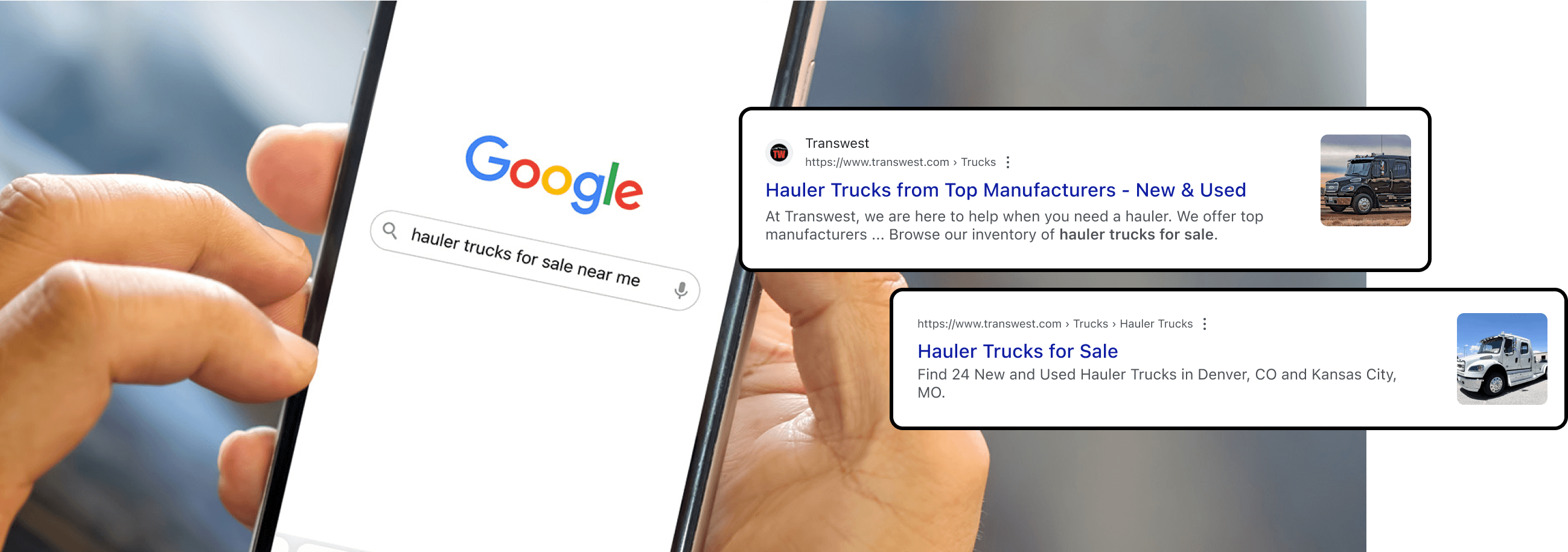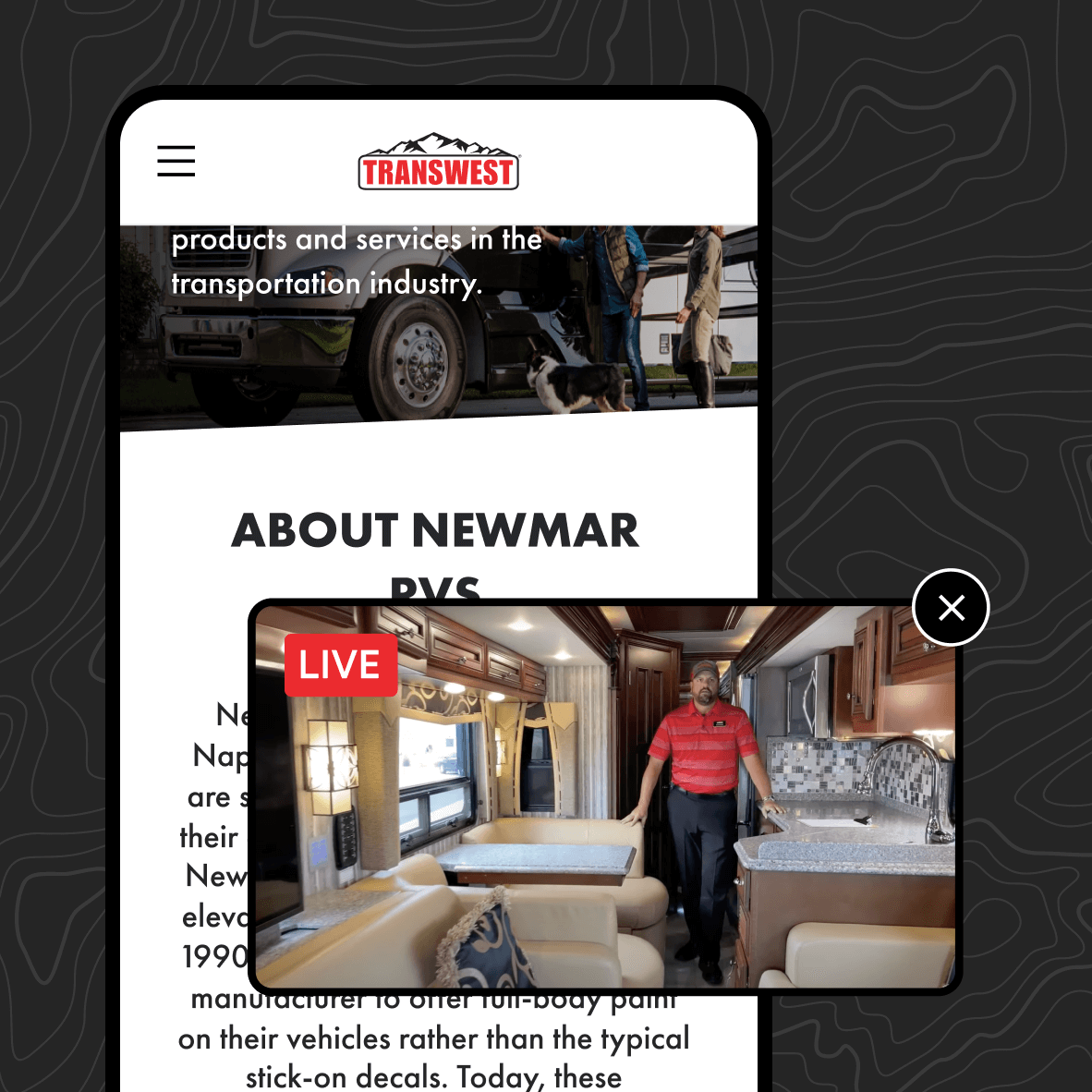Transwest website
Comprehensive website redesign, migration, and workflow integration are just a few of the things we use to help Transwest’s digital presence match their status in the RV and commercial transportation industries.

About Transwest
Transwest is a national leader in transportation sales based in Denver, Colorado. They sell automotives, commercial trailers, trucks, horse/livestock trailers, and RVs (recreational vehicles) for individual and commercial use. They have a sterling reputation for trustworthiness and outstanding customer service supported by a large network of repeat customer and referral sales.
Deliverables
Reimagined information architecture
Industry-tailored faceted search
Future-oriented content
Although Transwest has a great real-life reputation, their website posed some key challenges for us to tackle together:
Muddled distinction between divisions
Each division - automotives, commercial trailers, trucks, horse/livestock trailers, and RVs, previously had its own website, and the relationships between divisions were unclear.
Lackluster search engine ranking
Despite their reputation, Transwest’s search engine ranking and online presence did not reflect their status as an industry leader.
Confusing navigation
Users were frequently lost trying to find their way through siloed division websites.

Over the last few years, we’ve helped Transwest streamline processes and improve their user experience and search engine results ranking.
Single domain strategy
We knew a key piece to Transwest’s website redesign would be thoroughly reimagining their information architecture. Prior to our engagement, each division of the company - commercial trailers, horse & livestock, RV, trucks, and automotives - had separate websites, which was not only confusing, but it also negatively impacted their SEO standing.
To address this, we assigned each business group within Transwest a dedicated page path within a shared, single domain. Transwest’s divisions, renamed “groups,” now operate under a shared virtual model within a consolidated domain. This approach:
- Creates a clear, cohesive organizational structure
- Streamlines sales pipelines to and within the correct group
- Looks and feels more natural for users, reducing confusion
- Increases Transwest’s overall domain authority, profoundly impacting their SEO status

Industry-tailored faceted search experience
To update Transwest’s faceted search feature, we started by applying group-specific filters. Customers searching for a commercial trailer can now search by length, trailer hitch type, or other relevant terms. Meanwhile, those searching for RV or automotive inventory can sort by type, make, model, and more. This decreases user frustration and consolidates searches to relevant groups, thereby decreasing error and bounce opportunities.
We used Laravel’s Livewire as part of the website overhaul to allow Transwest’s faceted search to be server-side rendered. Server-side rendering enables search engines to index these pages more effectively, providing Transwest with another valuable SEO boost.
Deep dealer management system integrations
We continue to work with the extensive inventory integration demands of Transwest’s website, keeping in mind the importance of keeping live listings of available inventory at multiple locations uninterrupted.
To do this, we use various data endpoint methods (API, JSON, and XML) to pull inventory details from dealer management systems including Salesforce and Arcadium into a custom intermediary mySQL database. This database then feeds the inventory data into the new website using Laravel Eloquent ORM, which gives us the ongoing freedom to integrate existing data into the new website without sacrificing live inventory updates.
What happens if a searched item isn’t in stock?
If an item isn’t in stock, we designed and developed a soft 404 to display related in-stock items. If there’s still no inventory relevant to the user’s search, a contact form now displays, so potential buyers are never too far out of reach from a Transwest salesperson.

Inventory details pages
We created detailed inventory pages to display from faceted search or search engines. These dynamic, easily customizable pages are designed to allow potential buyers to truly envision themselves in the vehicle. FAQs and keyword-rich content, along with videos, floor plans, specifications, and images, enhance the domain authority of these pages and the Transwest site.
We also implemented structured data using the vehicle schema, which both improves the ranking of Transwest’s vehicle pages and allows inventory to display as rich results in search as product snippets. This displays photos, pricing, and top-level vehicle attributes directly in view, which increases click-through rate and provides visitors with a clear understanding of the page.

Long-term SEO strategy
We developed Transwest's dealership website with ambitious SEO goals in mind, since we wanted to see their authority in the industry reflected in their search engine results page ranking (SERP). Using the single domain strategy, it’s easy to link to relevant products within blog posts, make comparisons between products, and delve into current trends within and between each group, all of which improves Transwest’s SEO standing and translates to sales.
Page load speed enhancements
Another way we’ve improved Transwest’s search ranking is by improving their page load speed. We started by completing an audit of every page on the site and removing duplicate queries. We then optimized the remaining pages, which required us to re-factor many existing components.
We also use a Redis cache to store heavier queries and lazy load all videos to limit the effects of these heavy data requests on page load speed.
Product schema structured data
We added product schema data to every product page, improving the quality of Google’s index of Transwest’s inventory. By controlling what Google indexes about a product page, we help make the search engine’s listing more accurate and informative, which results in higher click-through rates.
Product schema also allows product pages to show up in organic search results with rich product results, bringing impressions and clicks from the improved listing.

Future-oriented content strategy
One of the major focuses in the Transwest project has been to establish and maintain the brand as an online authority in the industry by using timely, useful, and relevant content. To add search authority to each vehicle group, we created separate blogs for each. Posts are now categorized by vehicle group and linked from the group’s different content pages to increase visibility. And the brand as a whole enjoys an SEO boost from the increased authority at the group level, thanks to the single-domain strategy.
SEO focused pillar pages
In addition to the blog and assisting Transwest staff to update the site’s copy, we also created pillar pages for makes, models, industries, and vehicle types. These pillar pages draw in broader search audiences and cross-promote related vehicles. They include SEO-friendly FAQs, granular details about the searched topic, images, and more to entice audiences to contact Transwest’s sales team to make a purchase.
Custom, easy-to-use CMS
Using Laravel Nova, we built a custom content management system (CMS) that supports easy content addition and revision, complementing the focused blog and page content creation plan we implemented.
Individual contributors at Transwest can now easily add and update their own content, adding filters, sliders, images, videos, and more.


YouTube livestream embeds
Videos are valuable from an SEO point of view, but they are invaluable for salespeople, especially when they have a customer who is considering a large purchase like an RV. So it was important for Transwest to feature video walkthroughs on pages to help both their sales team and searchability.
Using Laravel Livewire, we pull Livestream videos from Transwest’s YouTube channel and embed them onto the Transwest site in real time. This allows videos to load faster and feel more natural for users while showcasing vehicle videos and capitalizing on valuable video information from YouTube.

Data-driven UX design
We used data-driven UX R&D to redesign Transwest’s website, creating a seamless online user experience. Because of this, their website now emulates the customer-focused experience that Transwest is reputed for at their brick-and-mortar locations.
New headers/footers, iconography, URL anatomy, and group homepages display both the Transwest brand and the unique groups contained within it. These changes harmoniously incorporate every group under a shared visual representation of the brand’s overall identity. And the improved user experience translates to increased traffic and conversions, turning website window shoppers into real customers for Transwest.
Results to date
By the Pixel has revamped Transwest’s digital presence and back-end operations through modern web and application design, intuitive user experiences, and deep integrations with dealer management and CRM systems. We continue to make changes based on new information, and we look forward to providing Transwest with the latest technological solutions that suit their business demands well into the future.
Overall organic search traffic increased almost threefold
Our initial efforts nearly tripled their organic traffic over the course of a single year, and our ongoing work continues to drive organic traffic through search results and AI citations.
230% increase in overall conversions
We helped Transwest more than double their monthly average conversions from the site (including contact form and credit application fills) and brought in more loyal customers.
14x more conversions through blog posts
Thanks to our work adding numerous valuable and rich content blog posts, we’ve brought in substantially more traffic to the Transwest website overall.

